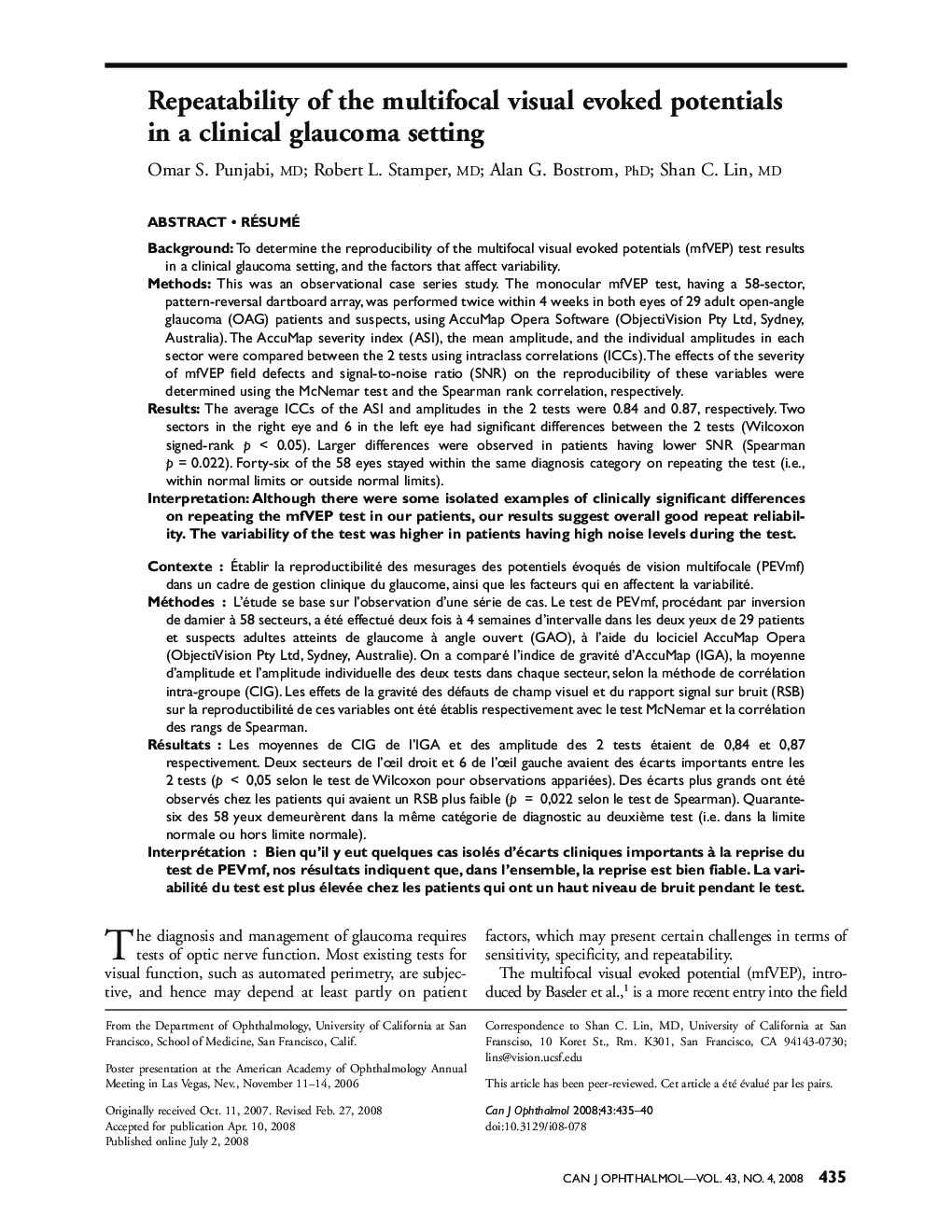| کد مقاله | کد نشریه | سال انتشار | مقاله انگلیسی | نسخه تمام متن |
|---|---|---|---|---|
| 4010478 | 1602442 | 2008 | 6 صفحه PDF | دانلود رایگان |

Background: To determine the reproducibility of the multifocal visual evoked potentials (mfVEP) test results in a clinical glaucoma setting, and the factors that affect variability.Methods: This was an observational case series study. The monocular mfVEP test, having a 58-sector, pattern-reversal dartboard array, was performed twice within 4 weeks in both eyes of 29 adult open-angle glaucoma (OAG) patients and suspects, using AccuMap Opera Software (ObjectiVision Pty Ltd, Sydney, Australia). The AccuMap severity index (ASI), the mean amplitude, and the individual amplitudes in each sector were compared between the 2 tests using intraclass correlations (ICCs).The effects of the severity of mfVEP field defects and signal-to-noise ratio (SNR) on the reproducibility of these variables were determined using the McNemar test and the Spearman rank correlation, respectively.Results: The average ICCs of the ASI and amplitudes in the 2 tests were 0.84 and 0.87, respectively. Two sectors in the right eye and 6 in the left eye had significant differences between the 2 tests (Wilcoxon signed-rank p < 0.05). Larger differences were observed in patients having lower SNR (Spearman p = 0.022). Forty-six of the 58 eyes stayed within the same diagnosis category on repeating the test (i.e., within normal limits or outside normal limits).Interpretation: Although there were some isolated examples of clinically significant differences on repeating the mfVEP test in our patients, our results suggest overall good repeat reliability. The variability of the test was higher in patients having high noise levels during the test.
RésuméContexte: Établir la reproductibilité des mesurages des potentiels évoqués de vision multifocale (PEVmf) dans un cadre de gestion clinique du glaucome, ainsi que les facteurs qui en affectent la variabilité.Méthodes: L’étude se base sur l’observation d'une série de cas. Le test de PEVmf, procédant par inversion de damier à 58 secteurs, a été effectué deux fois à 4 semaines d'intervalle dans les deux yeux de 29 patients et suspects adultes atteints de glaucome à angle ouvert (GAO), à l’aide du lociciel AccuMap Opera (ObjectiVision Pty Ltd, Sydney, Australie). On a comparé l’indice de gravité d'AccuMap (IGA), la moyenne d'amplitude et l’amplitude individuelle des deux tests dans chaque secteur, selon la méthode de corrélation intra-groupe (CIG). Les effets de la gravité des défauts de champ visuel et du rapport signal sur bruit (RSB) sur la reproductibilité de ces variables ont été établis respectivement avec le test McNemar et la corrélation des rangs de Spearman.Résultats: Les moyennes de CIG de l’IGA et des amplitude des 2 tests étaient de 0,84 et 0,87 respectivement. Deux secteurs de l’œil droit et 6 de l’œil gauche avaient des écarts importants entre les 2 tests (p < 0,05 selon le test de Wilcoxon pour observations appariées). Des écarts plus grands ont été observés chez les patients qui avaient un RSB plus faible (p = 0,022 selon le test de Spearman). Quarantesix des 58 yeux demeurèrent dans la même catégorie de diagnostic au deuxième test (i.e. dans la limite normale ou hors limite normale).Interprétation: Bien qu'il y eut quelques cas isolés d'écarts cliniques importants à la reprise du test de PEVmf, nos résultats indiquent que, dans l’ensemble, la reprise est bien fiable. La variabilité du test est plus élevée chez les patients qui ont un haut niveau de bruit pendant le test.
Journal: Canadian Journal of Ophthalmology / Journal Canadien d'Ophtalmologie - Volume 43, Issue 4, August 2008, Pages 435-440